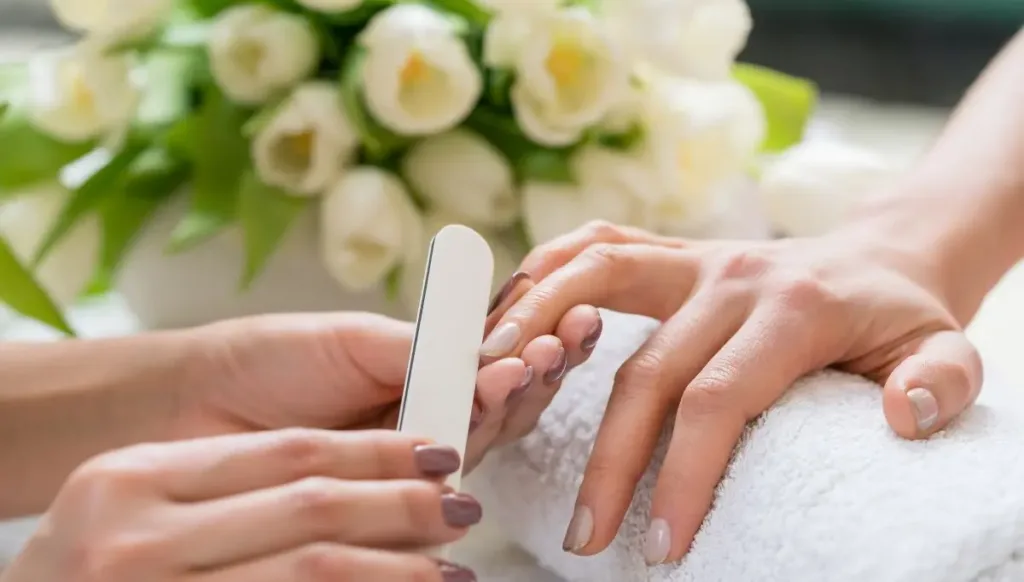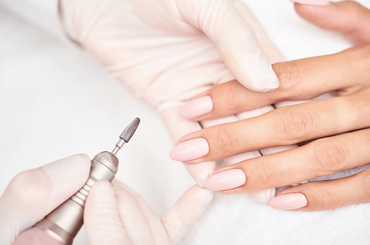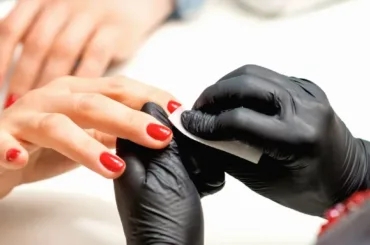Buffing nails is a common practice to achieve a smooth and shiny surface. However, it has also become a highly controversial topic among nail lovers, making many ladies question, does buffing nails damage them?
No, buffing nails doesn’t damage the nails when done the right way, but buffing, when done excessively or aggressively, can potentially damage your nails.
However, while it can make your nails look neat, there are a few things to consider for the safety of your nails. Let’s look at what needs to be considered in this post.
7 Pros Of Buffing Your Nails
Buffing nails is a nail care technique that offers several positive effects, enhancing your nails’ overall appearance and health; these benefits include;
1. Smoother nail surface
Buffing helps smooth nail surfaces by removing ridges, bumps, and imperfections. Which will eventually make your nails look well-groomed, polished, and neat.
2. Natural nail Shine
Buffing gives nails a neat and natural glossy shine without the need for nail polish. This makes buffing appealing for those who prefer a natural and elegant look.
3. Improved nail health
Another positive effect of gentle buffing is that it stimulates blood circulation to the nail bed, promoting healthier nail growth. It can also help remove any accumulated debris from the nail surface.
4. Prepares nails for polish
Buffing primes the nail surface, providing a smoother canvas or layer for applying nail polish. This will lead to better adhesion and a more polished finish when using nail colors, thereby making your manicure last longer.
5. Remove nail stains
Buffing nails is also a way to help remove and minimize the appearance of nail stains and discoloration. When you gently rub the nails, you remove the stains on the top layer, and you will achieve a cleaner look.
6. Promotes hydration absorption
Buffing can help nail oils and moisturizers absorb better into the nail plate, contributing to healthier and more moisturized nails.
7. Fosters nail awareness
While buffing, you might notice any changes or irregularities in your nails. This increased attention can lead to early detection of potential nail issues. Incorporating buffing into your nail care routine can add a layer of care. It’s a quick and easy way to maintain the appearance of your nails between manicures.
6 Cons Of Buffing Your Nails
Buffing nails has adverse effects when done incorrectly or excessively; let’s take a look at this setback
1. Thinning of nail layers
One of the major concerns of people against buffing is that it involves sanding the nail’s top layers, called the keratin layer. This layer serves as a shield for the nail; when it’s removed (excessive buffing) too much, Over time, it can lead to thinning of these layers, making the nails weaker and more prone to breakage.
2. Weakening of nails
Another setback of buffing, when done excessively, is that it generates heat and friction, which might weaken the nails. Aggressive buffing or using a rough buffer will strip away the protective layers of the nails, causing them to become more brittle.
3. Natural oils removal
Overbuffing can remove the natural oils that keep the nails moisturized. This can result in dry, brittle nails that are more likely to split.
4. Irregularities and Damage
If not done carefully, buffing can cause irregularities in the nail surface. Overzealous buffing can even lead to nail damage, such as peeling and cracking.
5. Delayed regrowth
Excessive buffing might slow down the natural regrowth of nails, as it can affect the nail matrix (the base of the nail).
6. Fungal infection risk
Another risk associated with buffing is that if you share buffing tools or use them on unclean nails, it can lead to fungal infections being spread.
How to Minimize Negative Effects Of Buffing
To minimize the potential negative effects of buffing :
- Limit the frequency of buffing the nails that buff nails sparingly, ideally once a month or less.
- Use Gentle buffers to buff. Choose soft, fine-grit buffers and apply gentle pressure.
- Avoid using metal buffers to buff, as they are more abrasive and should be avoided.
- Moisturize your nail after buffing by applying a nail oil or moisturizer to keep nails hydrated after buffing.
- Consider getting your nails buffed by a professional to minimize the risk of damage if you don’t feel confident doing them yourself.
Why Do Manicurist Buff Nails?
You might be wondering why your nail technician buffs your nail before applying nail polish well; buffing involves using a soft buffer to rub the nail’s surface gently, which helps to remove ridges and stains and create a polished appearance.
Also, it enhances polish adhesion to the nail well, making it one of the processes nail technicians use during manicure sessions. However, excessive buffing can thin out the nails and weaken them over time.
How To Buff Nails Safely
If you want to buff your nails without causing damage and enjoy the benefit, here are some tips
- Hold the buffer parallel to your nail and place the large grit side of the buffer on your nail.
- Using unidirectional strokes and buff your nail in an X shape.
- Ensure you use a soft buffer and apply gentle pressure. Avoid vigorous rubbing that could thin out the nails.
- Since over-buffing can damage your nails, use only six to eight strokes to buff them.
- Repeat this process for each nail.
- After buffing, apply a good nail oil or moisturizer to keep the nails hydrated.
How Often Should I Buff My Nails
You should not buff your more than once a month, as frequent buffing will only wear out your nails, causing them to thin out and split. Therefore, it is best to avoid buffing too often or, better still, limit buffing to your monthly manicure and pedicure session to allow your nails time to recover.
Frequently Asked Questions
Is buffing excellent or bad for nails?
Buffing nails is good for the overall beauty of the nails, and among many other merits of buffing the nails is the fact that they add a natural shine to the nail. However, even though buffing nails can enhance nail beauty, it can also endanger it when done aggressively or frequently using the wrong tool.
Can you buff nails without buffer?
Yes, you can use many other alternatives at home to buff your nail, so if you don’t have a buffer, you can still buff your nails with a soft bristle toothbrush or sandpaper.
How long do buffing nails last?
In most cases, when you buff your nails, the shine will last for a week. Moreover, how you buff your nails and moisturize your nails and the tool you use will determine how long the glow lasts.
Conclusion
Buffing nails is an excellent way of achieving a smoother appearance and natural shine. However, excessive or aggressive buffing can weaken nails, thin them out, and remove essential oils. To enjoy the benefits of buffing while minimizing potential har
In this post, other benefits buffing nails offer, like smoother surfaces, natural shine, and improved nail health, have been discussed. You can enjoy these positive effects and maintain healthy, attractive nails by incorporating gentle buffing into your nail care routine.






